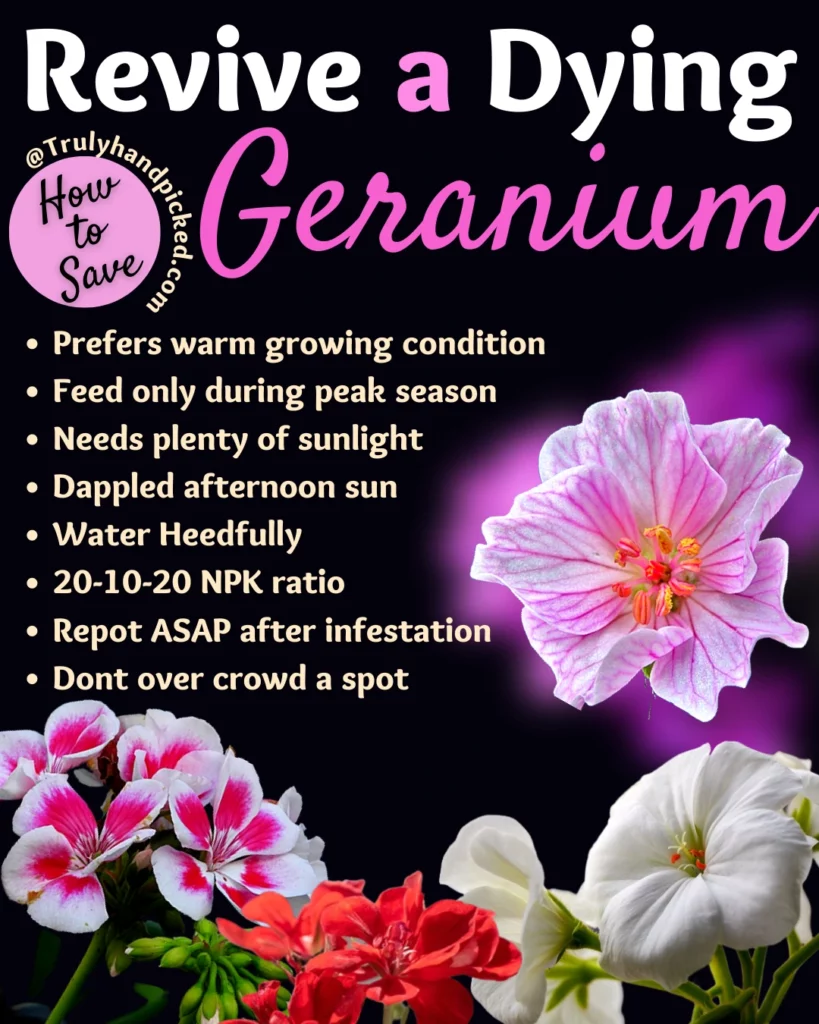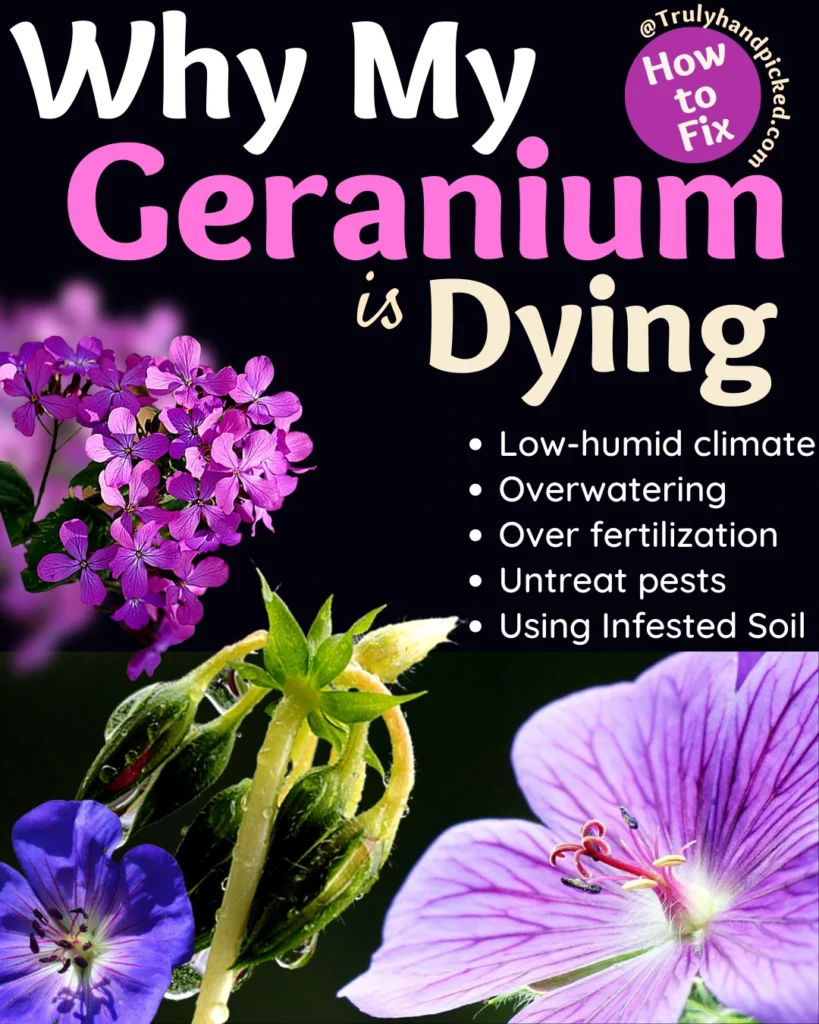Geranium can grow from seeds quickly with growing provisions and a little care. However, geraniums thrive more rapidly while cultivated from cuttings or small plant forms instead of seeds.
Why Geraniums are Dying: Either its frost (will come back in spring), under or over watering (watering stress), not enough sunlight, low humid places, overfeeding in wrong season, rotting (stem & root), Baterial or fungal attack and at sometimes its transplant shock.
Cranesbills aka geranium mostly cultivates for their attractive and colorful blossoms. This easy-to-care plant sometimes acts susceptible to consecutive negligence in its daily caring routine.
Geraniums are flowering houseplants with a plethora of different species. It can be annual, biennial, and sometimes perennial too, depending on its selective genus.
They start suffering from some serious troubleshooting issues for such causes. Today we emerge with the most typical one among those issues-
Why Are My Geraniums Dying?
A fully thrived geranium plant can live up to two to three years long, naturally. This period can extend or shrink relying on several things.
Sometimes, a great addition to your garden, geraniums can turn into trouble themselves when they start dying early without any particular trace. This problem can occur due to some specific reasons, such as-
Unsuitable Humidity Level:
Geraniums are quite undemanding about climate and they can survive in most temperatures.
However, they prefer a quite particular type of humidity to thrive well. If you don’t provide them so, your geranium may get a problem surviving. This kind of issue occurs when –
- You stay attentive to the humidity needs of your plant for long
- And place your plant in a spot with extremely dry humidity with poor air circulation
Related: My geranium is not blooming
Overwatering:
Overwatering can damage the health of any growing plant extremely instead of enhancing the roots. Some plants are way more sensitive to extreme hydration than dehydration and geraniums are one of them.
Excessive watering can make the growing medium unnecessarily soggy and suffocate the roots badly. If your plant indicates the signs of overwatering, you must make such mistakes-
- Watering your plant more than twice a week, even in the high-humid climates
- And never let the soil, as well as the roots, dry between watering
Overfertilization:
You must know that geraniums are sensitive plants. They can’t tolerate any excessive things in their daily regimen, whether it is water or food. Thus, geraniums can’t stand overfertilization as well as overwatering.
Excess water can suffocate the roots while excess fertilization asphyxiates the stems. A consecutive period of overfertilization can cause the death of your growing geraniums after a certain period. Overfertilization means-
- You must feed your plant more than twice a year with the wrong NPK ratio
- Or your plant may initiate an abnormal root system due to overfeeding schedule
Related: How to save a yucca cane plant – quick tips
Untreated Pests and Bugs:
Geraniums produce flourishing green foliage along with vibrant flowers. These leaves are scrumptious to some bugs and insects.
Caterpillars, moth, budworms, mealybugs, spider mites, etc. are some common insects that often attacks geraniums for their luscious leaves. Initially, they give the sign by biting the foliage in holes. These insects turn fatal to your plant, when-
- You don’t apply for protection from possible insects once your plant starts thriving flourishingly
- Or if you don’t apply any remedies for the pest’s attack after detecting them on your plant
Uncured Diseases:
Geranium rust or bacterial disease or fungal attacks are as bad as these insects. They will appear with small yellowish or brownish spots on the foliage surface at first.
Eventually, these spots will incorporate the entire leaves and kill them gradually. Fungal disease even attacks the soil first then the plant and progressively incorporates the roots entirely. These types of problems occur when you-
- Using infected soil or pot or seeds to grow your geraniums
- Or if you keep your geraniums in a cold, low-humid, and water-logged condition for long
Related: How to save a dying umbrella plant

How to Save Geraniums From Dying?
To save your geraniums from such dying conditions and restore their thriving as well as blooming forms, try to follow these hacks accurately-
Preferable Humidity:
- Provide your plant with a moderately warm growing condition with high humidity
- Use an artificial humidifier to keep the humidity level of the room always high
- Place your planter in a tray with water and pebbles
- Maintain good air circulation at the spot where your place your growing geraniums
Water Heedfully:
- Water your plant thoroughly after the plantation
- Then, wait till the topsoil surface turns 1-2 inches dry before watering
- Avoid normal tap water and always use distilled or filtered water to hydrate geraniums
- Look for well-drained potting soil and pot with a good drainage system to avoid possible watering damage entirely
Related: How to save a dying watermelon peperomia
Feed Mindfully:
- Make the soil fertile during the plantation with compost or normal plant food
- Skip monthly fertilization and feed your plant only during the peak months
- Keep the phosphorus content lower than nitrogen and potassium in your fertilizer
- And apply the fertilizer in diluted form with a 20-10-20 NPK ratio
Be Safe From Pests’ Attacks:
- Rinse your plant with flush water once a week
- Give your plant a regular checkup with a close inspection to find the tiniest infestation of pests
- Collect the bugs or insects manually with your hand and clean the spot with the rub of a homemade pesticide solution
- And give your plant a good bath with homemade insecticide spray once a week just be on the safe side
Stay Away From Disease Contamination:
- To keep your plant away from the grasp of any kind of disease, keep it in a spot with plenty of sunlight
- Use soil, potting mix, plantation tools, and seeds or plants which are any type of disease-free
- Change the soil or pot immediately once you detect any sign of fungal or bacterial infestation on your plant
- Spray a chemical-free fungicide spray on your plant once in a while and place your plant where it can get good air circulation
Related: Quick tips on how to save an overwatered succulent
Geranium Quick Care FAQ
Q: What is the best place to grow geraniums?
Pick a place where your plant can get direct morning sunlight but a little shade from the dappled afternoon sun
Q: What type of soil is best for geraniums?
Choose dense soil to grow your geraniums and loose enough for well draining and make it fertile with the right amount of compost mix.
Q: How much space should be given to each geranium plant?
Give your plant enough space to thrive without touching each other, while growing in bunches.
Q: How often do I need to water geraniums?
Never let your plant suffer from drought stress in the way of avoiding overwatering, and water it weekly as needed
Q: How often should I fertilize my geraniums?
Feed your geraniums with a thin layer of compost mix every spring and use mulching immediately after fertilization.
Q: How often should I prune my geraniums?
Prune your plant monthly after letting them reach a decent length and bushy form.
Q: How often should I repot or separate my geraniums?
Repot or separate your growing geraniums every year to offer them enough space
Q: What kind of protection should I provide for my geraniums?
Keep them protected from the touch of disease and pests attentively throughout the entire growing session of your geraniums to let them happy without any deadly consequence.
Just have a walk twice a week around your indoor or outdoor garden plants to find out about pests or fungal attacks asap.
Q: Can You Bring Back Dead Geraniums?
A dying geranium plant can revive and avoid its fatal moment successfully if you can detect the signs at the early stage and reverse them accurately with suitable remedies.
What Is The Best Time To Plant Geraniums?
The best period to grow geraniums from seeds is anytime between early to mid-February. However, you can start the planation course anytime in spring, while growing it from cuttings or tiny nursery plant forms.
